Welcome to our guide to climbing Mont Blanc – or White Mountain – the highest mountain in the Alps and all of Western Europe.
The ascent of Mont Blanc promises a breath-taking experience – but, like any serious climb, it poses risks. It is therefore important that you know what you are getting yourself into and that you are properly prepared.
For popular hikes in the regions, see: Tour du Mont Blanc, Tour de Monte Rosa and Haute Route.
Mont Blanc Overview
Western Europe’s highest peak, Mont Blanc (4,810m), is located on the border of France and Italy in the Alps. It was first summited in 1786 by Jacques Balmat and Dr Michel Paccard, local mountaineers.
Mont Blanc pours its imposing shadow over the town of Chamonix which is easily accessible from around the world.
Climbing the mountain is a challenging experience and a rite of passage for any serious climber, but is also a realistic goal for newbie climbers, making it one of the most popular climbing destinations globally.
Mount Elbrus vs Mont Blanc
Although many people assume that Mont Blanc is the highest mountain in Europe, it is in fact Mount Elbrus in the Causcasus Mountain Range in Russia that takes first place.
The two are often compared, they are both graded PD – and are therefore of similar difficulty.
The main difference between these imposing climbs is their altitude (4,810m on Mont Blanc vs 5,642m on Elbrus) and the weather (Mount Elbrus is much colder than its Western counterpart).
This means that a little more preparation and acclimatisation is necessary before you take on Mount Elbrus and many opt for the more manageable Mont Blanc instead.
See more details on European mountain ranges.
Route Options
The most common routes up Mont Blanc from Chamonix is detailed below.
Goûter Hut Route
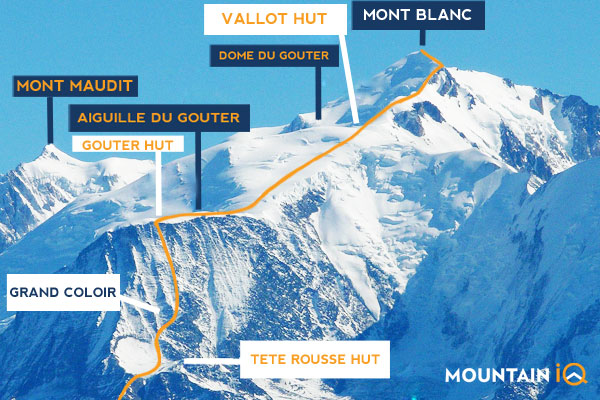
The Goûter Hut Route is the most popular route up Mont Blanc and is generally considered the easiest, although there are still technically challenging areas and the hazard of rock-fall.
The Goûter Hut route starts at Les Houches, from where you take the cable car to Bellevue followed by the Tramway du Mont Blanc to the Nid d’Aigle (2,372m).
From here there is a rock-and-snow scramble to either Tête Rousse hut (3,167m) or the Goûter hut (3817m) where you will stay overnight.
The first section of the ascent is relatively easy walking terrain, but once you pass Tête Rousse you will traverse the infamous Grand Couloir.
Staying at the Tête Rousse hut is typically preferred if you want to cross the Grand Couloir at a better time-of-day and have a quieter evening rest.
The Grand Couloir is a wide gully which is known for a high frequency of rock fall, and should be crossed as quickly as possible to minimise the risk of an accident. The last 550m to the hut is a tough scramble, especially after a long day’s exertion.
From the second day onwards, you will be crossing glacial terrain, so crampons, harnesses and ropes are required. Most of the day is just a long gradual incline, without any particularly steep sections.
You will walk past the Vallot shelter, which can be used as an emergency bivouac, and then you’ll traverse the Bosses ridge, bracketed by the two protrusions which characterise the skyline as seen from the valley.
After about 4 and a half hours of technical climbing, using crampons and other equipment, you will reach the summit.
On the way down, you have a couple of options; either via the same route as up, or past Aiguille du Midi.
Alpine Grade: PD
Here are some details that might be useful to plan your trip:
- For the rates of the cable car, click here.
- For the Goûter Hut reservations, email Antoine Rattin: [email protected], or click here.
- For the Tête Rousse, phone +33 (0)4 50 58 24 97
The Trois Monts Route
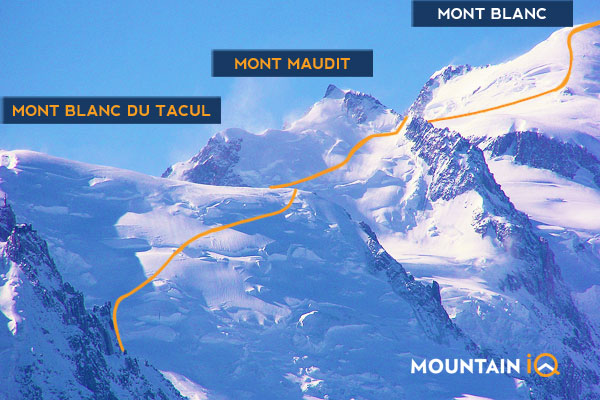
The Trois Monts Route starts by taking the cable car to Aguille du Midi (3,842m), and is followed by a descent on the Aguille du Midi arête to the glacier du Tacul and an easy, quick walk to the Cosmique Refuge (3,613m).
Early on Day 2, you will begin the climb of Mont Blanc du Tacul, a difficult ascent which has been known to present steep and exposed terrain due to the opening of crevasses.
Once atop Mont Blanc du Tacul, you will cross over the Col du Mont Maudit and ascend the long, snowy incline to the final section of technical terrain.
This climb can be very steep and requires skilled front-pointing, as well as the use of an ice axe. Plan your route carefully because this part of the route can be packed with climbers.
Then, there is a brief descent to Col de la Brenva, and finally a climb to the summit. You can descend Mont Blanc via the same route or via the Goûter Hut and complete the traverse of the mountain.
This route is technically and physically more challenging that the classic Goûter Hut option because of the steeper icy slopes – experience with crampon technique is necessary. However, the route is more scenically beautiful and less busy with fellow climbers.
The Cosmique Refuge is also slightly more comfortable than the Goûter Hut, allowing for a better night’s sleep before the summit.
Alpine grade: PD. This route requires good physical strength and crampon technique. You will also require your own personal guide for this route, due to its difficulty.
For reservations of the Cosmique Hut, phone +33 (0)4 50 54 40 16. See above, under the Goûter Hut for more information on planning.
Italian Route via the Gonella Hut
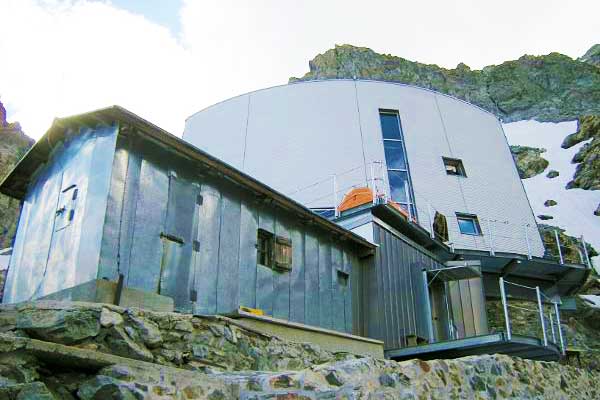
The Italian Route via the Gonella Hut is generally only available in the summer months of May, June and July.
However, if you are planning your trip for this period, it is a spectacular alternative to the Goûter Hut route, and it is relatively quiet.
This route starts in the Val Veny, from where you will ascend the Miage Glacier to the Gonella Hut to stay overnight.
On summit day, you will climb the Col de Bionnassay and then join the normal Goûter route to the Mont Blanc Summit.
Climb Mont Blanc in Winter
If you are looking to climb up with a pair of skis or snowboard for an epic descent, you have a few winter options. These include “The Three Mont Blancs”, “The Corridor Route” and “The Descent of the North Face”.
The most popular, but the most dangerous route is the “Classic Route”, for which you can stay in the Grands Mulets hut (3051m).
Typical Itinerary
Below is an example of an itinerary of the entire Mont Blanc expedition.
There are many variations on this schedule, depending on the tour group you have chosen – however the few days spent acclimatizing are highly recommended.
Day 1: Fly in and Get Settled. Fly into Geneva, travel to Chamonix and arrive at your hotel for a briefing
Day 2: Training at Rifugio Chabod. Organise any last-minute equipment in Chamonix, 1.5h drive to Rifugio Chabod in Gran Paradiso National Park. Hike to the hut for lunch and complete you first training session.
Day 3: First Proper Climb up Gran Paradiso. You will have an early wake up call for the 1300m climb up Gran Paradiso, Italy’s highest mountain. The terrain is mostly snowy, as well as a final rocky scramble to the peak.
Day 4: A descent into the valley. Day 4 comprises a gradual descent into the surrounding valley, where you can stop for a scrumptious Italian coffee. You will then be driven back to your hotel.
Day 5: Cable car and Ascent to Tête Rousse Hut. You will drive early to Les Houches to catch the Bellevue cable car and Tramway du Mont Blanc to Refuge du Nid d’Aigle. This will be followed by the hike to Tête Rousse Hut, where you will spend the night.
Day 6: Summiting Mont Blanc. Day 6 is a long day of hiking – about 8 to 12 hours to reach the peak. The day will start with a scramble past the refuge de Goûter, after which you will traverse the Bosses ridge to the summit of Mont Blanc. After spending a few minutes relishing you achievement, you will climb back down for a night in the Goûter Hut.
Day 7: Return to your Hotel via the Tramway and Cable Car. The same route is taken to descend the impressive mountain, including the Tramway du Mont Blanc and the Bellevue cable car. Finally, you will arrive in your chalet for a much-anticipated celebratory dinner.
Day 8: Departure Day. After an early morning breakfast, you will check out of the hotel and make your way to you next destination.
Best Time To Climb
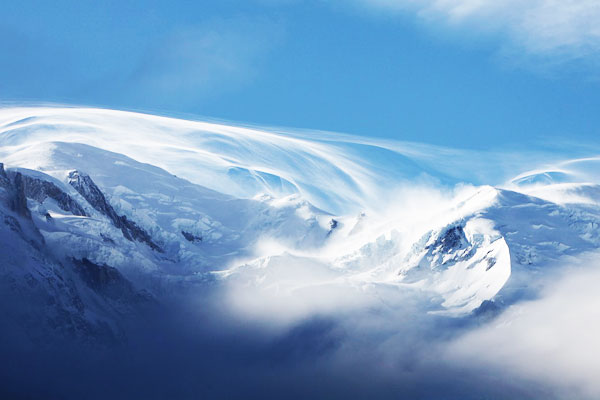
The best time to climb most of the routes summarized above is during the summer months of June to September.
The weather on Mont Blanc is however notoriously unpredictable, and severe snowstorms frequently strike the peak even in the middle of summer.
It is therefore important that you check the weather forecast before your ascent – and that you pack accordingly.
If you are a particularly experienced climber and are eager to avoid the crowds, many of the routes are still manageable in spring and autumn.
Remember that if you want to do the epic ski down the mountain, you will have to go in winter. These options are a lot more dangerous though.
Getting Here
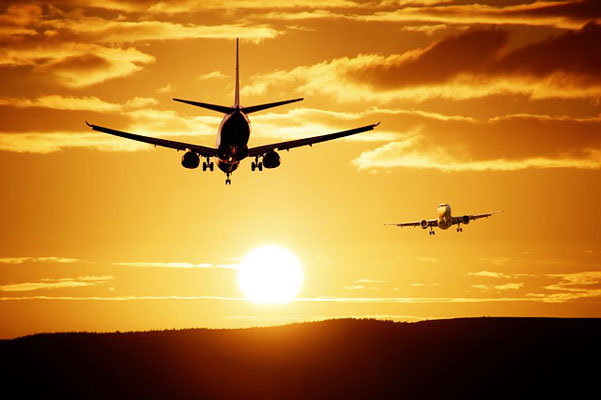
Most of the tours start from Chamonix, France, which is easily accessible from the Geneva Airport via a one-hour drive in a shuttle bus.
It is also possible to climb from Courmayeur, which is in Italy. This option is far less common.
While you are here, have a look at other amazing treks in France.
Training for Mont Blanc
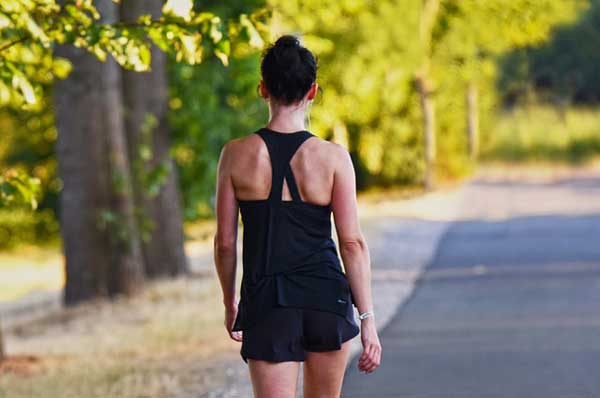
Firstly, there are certain technical skills that you will need to have mastered prior to you climb of Mont Blanc.
Specifically, you will need to know how to use an ice axe, crampons and how to adjust your climbing rope.
These techniques can be learned in the few preparation days, but it is advised that you have encountered them previously. You will also need experience traversing varied terrain.
Physically, you will also need to be in good condition. Good aerobic training, such as running, cycling or swimming three/four times a week for the months preceding your trip is essential.
In addition to this, it is a good idea to work on your leg, arm and core strength, as climbing is known to use both upper and lower-body muscles.
How Difficult Is The Mont Blanc Climb?
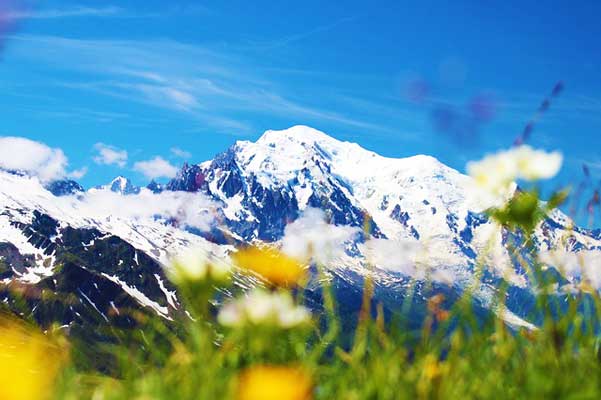
Nobody could describe the Mont Blanc ascent as ‘easy’, and the differing accounts generally can be explained by differing expectations.
For a hike, this is technically very challenging. For a climb, however, Mont Blanc is a relatively manageable option.
If you are hiking the “normal”, Goûter Hut route, the most challenging section will be that which leads to the hut itself – the Grand Couloir.
This section is rocky, icy and snowy and carries the risk of rock-fall.
The Trois Monts route includes a few steep and icy ascents, particularly that leading up to Mont Maudit and is overall more challenging than the Goûter alternative.
The Italian route from the Gonella Hut is not as steep as the Trois Monts option, but is much longer and passes sustained glacial terrain.
The other routes up the mountain are less common and require much more serious mountaineering experience and skill.
How To Acclimatize
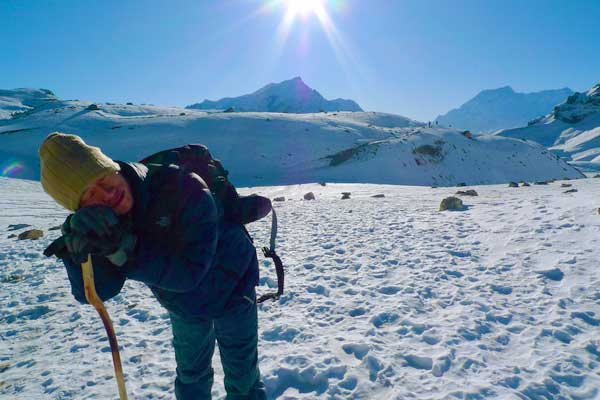
The effects of altitude sickness are commonly felt anywhere above 3000m above sea level, so for much of the Mont Blanc climb you are at risk.
Ensure that you are properly familiarized with the associated symptoms, which include fatigue, headaches and nausea.
Because there is no reliable way to predict whether you will be affected by altitude sickness – the likelihood of a person being affected is not correlated to his/her age, gender or fitness – everyone must spend a couple of days getting used to the new altitude.
This additional time is generally incorporated into your tour package and should be prioritized by individual hikers (we do not recommend that you hike alone – unless you are a very experienced climber).
In addition to leaving enough time for acclimatization, main rules we encourage you to follow are to avoid any alcohol or drugs (even sleeping tablets can push you over edge to a raging headache), to drink plenty of water and to ascend slowly enough.
If you are feeling anxious about the possibility of experiencing altitude sickness, visit your doctor for advice – he/she might be able to prescribe preventative medication.
How Busy Does The Mont Blanc Climb Get?
In total, 30,000 people summit the mountain each year, most of which happens in the summertime.
This roughly equates to about 200 people each day in peak season.
So, any idea that you might’ve had of a secluded, peaceful adventure alone with the mountain could not be further from the truth.
The lack of permits sometimes means that the number of people on the mountain is downright unpleasant.
How Dangerous Is The Mont Blanc Climb?
Do not undertake this journey without a realistic understanding of the risk you are taking in doing so.
This is a serious mountain to climb, and as such presents several life-threatening risks. There is the possibility of rock fall, avalanches, falling into crevasses and dangerously fast-changing weather conditions.
Most of the accidents incurred on the mountain affect parties who have opted to hike unguided. The best precaution you can take to minimize the risk of your hike is, therefore, to book a tour guide.
Mont Blanc Gear Check List
Clothing
Mountaineering Boots: Well insulated leather/synthetic boots are essential. Some great brands to try are La Sportiva, Scarpa, Millet and Salomon. Make sure that your boots fit your crampons.
Gaiters: Helpful to keep snow out of your trousers. If you are not expecting a storm, ankle gaiters should suffice
Socks: Pack a single mid-weight sock, preferably made of merino wool or a synthetic substitute. An additional pair of normal socks can be worn in the huts at night.
Trousers: stretchy, comfortable with a light soft-shell fabric. These should be partially resistant to snow, rain and wind.
Rain/Wind Trousers: in case of extreme weather, you will need an extra waterproof lightweight pair of trousers for protection. You may also what a two-ply Gore-tex option.
Rain/wind Parka: as lightweight as possible
Long underwear tops: lightweight, synthetic or merino wool layer
Long underwear bottoms: lightweight, synthetic or merino wool layer
Hut trousers: Bring an extra pair of “yoga” pants to wear in the hut, as lightweight as possible
Medium insulating shirt: lightly insulated synthetic shirt or jacket, such as Marmot’s DriClime wind shirt
Heavier insulating layer: Pack a lightweight down or equivalent sweater or pull-over. Good options include Marmot’s Zeus jacket and Patagonia’s Nano Puff Hoody
Gloves: for the higher glaciated sections and colder mornings we recommend that you also pack a shelled, warm glove. A light pair of “windstopper” gloves should be sufficient for most of your hike.
Climbing Gear
Ice axe: 50 to 60cm, lightweight axe recommended. For relatively unexperienced climbers, we suggest the light 52cm Petzl Summit, or the Summit Evo axe. The Petzl Sum’Tec is for slightly more technical climbers
Technical Ice tools: recommended if your hike includes steeper icy sections. Can be rented in Chamonix
Crampons: you should look for crampons which are easy to adjust while on the slope, which fit easily to your boots and have a flat frame, which prevents them from “balling up” wetter snow. Petzl Vasak is a good brand to look out for. Make sure that you avoid crampons with vertically oriented frames, as these are designed for waterfall climbing and are dangerous to use in the snow. Also avoid crampons with vertical front points.
Crampon anti balling plates: Rubber or plastic plates which prevent snow balling. Most crampons have in-built plates – double check in case.
Harness: Lightweight harness with belay loop. One good example is the CAMP Alpine Flash.
Rappel/Belay device: some options are the Black Diamond ATC Guide or the Petzl Reverso 4.
Climbing helmet: Lightweight is important such as Petzl Meteor or Sirocco.
Locking carabiners: bring at least two. Lightweight (less than 60 grams) such as the Petzl Spirit Crew Lock or the Sm’D.
Trekking Poles: Three-section foldable trekking poles are preferred. Avoid poles with bulky shock absorbers. We recommend the Leki Micro Vario Carbon.
Neck Gaiter: or a “buff” can act as an ear warmer, a headband, a hair tamer and whatever else you want it to do.
Other
Backpack: a lightweight pack with a capacity of about 30L is recommended. The Black Diamond Speed 30 or the Millet Prolighter 30+10 are good options.
Food: Although you will get most of your food at the huts, pack any extra food that you need. Remember to keep it light too.
Water bottle or thermos: capacity of 1 – 2 L. Avoid packing a water bladder as these are known to freeze over in particularly cold conditions
Headlamp: For example, the Petzl Actik Core
Pocket Knife: a simple and lightweight option such as the Victorinox Spartan model
Blister kit: moleskin and athletic tape are essential. Compeed, for example, is well worth the investment
Sunglasses: Get wrap-around glasses that protect your peripheral vision and filter out at least 90% of sunlight.
Sunscreen: Decant into a smaller container
Toiletries
Ear plugs: for noisy huts
Sleeping bag liner: Most huts require that you sleep in a lightweight liner in addition to the bedding they supply. This is for comfort and hygiene.
Camera, mobile phone, entertainment, chargers (optional)
Passport: you can leave it in your hotel and bring along a copy if you wish
Duffel: to leave behind extra clothes in the hotel
Euros: Necessary for hut extras and remote restaurants
Hats: Warm (beanie) and sun hat
Town clothes and shoes: not to be brought along on your hike itself
Permits & Costs
Permits are controversially not required for climbing Mont Blanc.
Unfortunately, this means that uncontrolled crowds of people often leave trash on the mountain and that many inexperienced trekkers unknowingly risk their lives by attempting the summit. On the upside, there is one less thing to organize.
The costs of the tours vary depending on the time of year you travel and the ratio of guides to trekkers.
Typically, for the all-inclusive tours you can expect to pay anywhere up to $4500, for a ratio of 1:1 on summit days and the extra Alpine training course beforehand.
Packages generally include accommodation, equipment, guides, local transport (excluding transfers from the airport, although this can be arranged) and a certain selection of meals.
Before you book your trip, ensure that you know exactly what you are paying for.
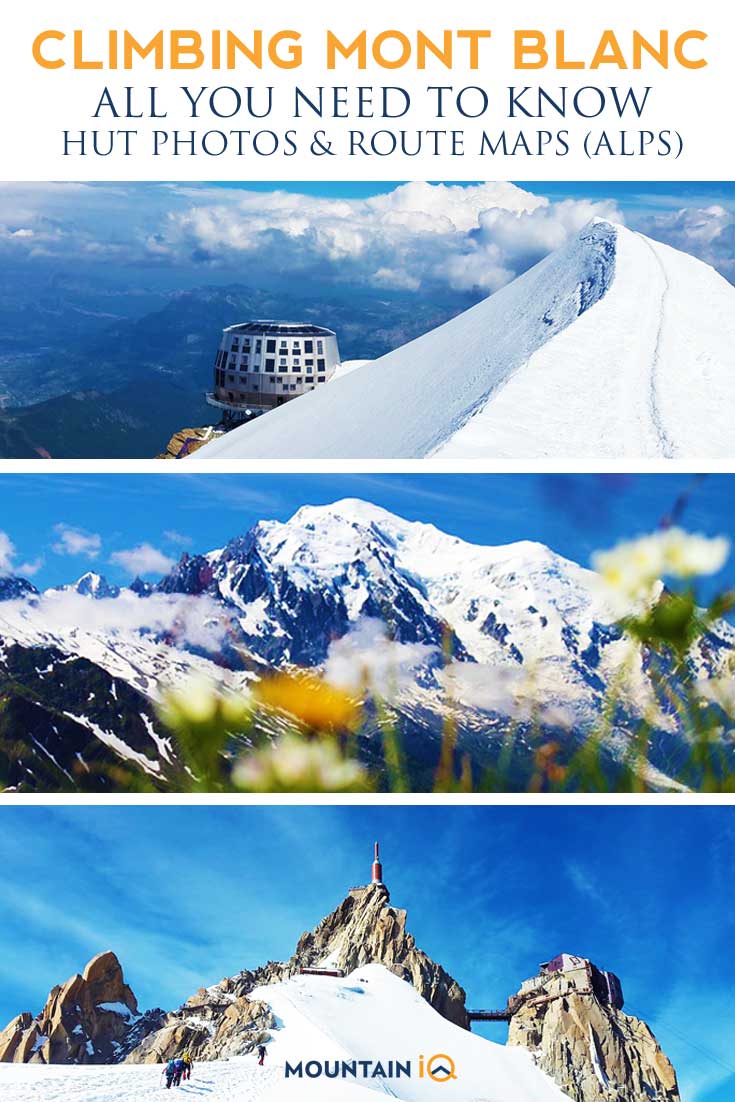

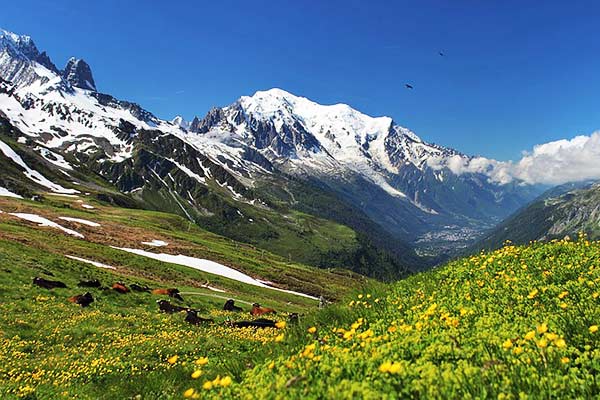
You can’t climb the mountain anymore without a reservation at one of the huts. The Gendarmerie (French mountain police) check you off the list as you approach Tete. Also, there’s a huge crevasse that opened up on the Bosses Ridge close to the summit. My understanding is you need a belay to get through it. I didn’t encounter this in my solo climb in 2021. And it is possible to have the mountain to yourself. Get up early and climb fast! I had the summit to myself and watched the sun come up.
Great insight, thanks Josh.